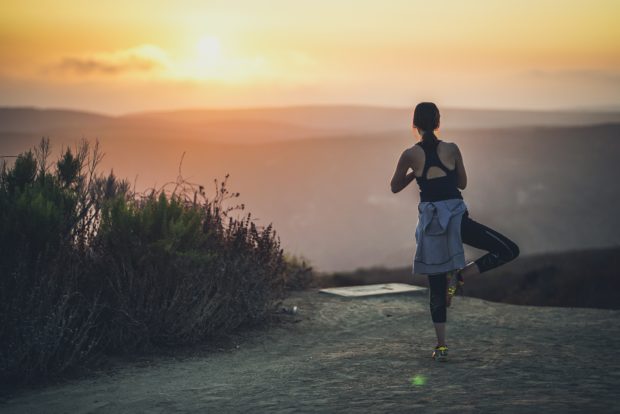
It's not true that you can't exercise with arthritis. In fact, it's a very good idea! Here's why
Regular exercise can make you feel and look fantastic – it will give you more confidence in your body and make you feel good about yourself psychologically and physically. And you can definitely still exercise with arthritis.
Exercise burns calories and helps you lose weight and keep it off. It can also increase your strength and suppleness. It’s just all-round terrific, and you don’t have to be super-sporty to get something out of it.
But it’s not always easy to exercise with arthritis if you find certain activities difficult and painful. It’s really important to find something you enjoy and something that suits your body, so that you can do it regularly. Make exercise fun, such as doing an Aquacise class with friends; your body weight will be suspended in the water which means less strain on your joints, and nobody can see if you’re doing it wrong! Exercise isn’t for everyone and some people may decide to take an easier approach, especially if their arthritis is causing them a significant amount of pain.
Or, try rolling exercise into your daily commute by cycling to work or college. Cycling puts less strain on the lower body joints, and is great for building up strength. Healthy, toned muscles act a bit like a corset, helping to strengthen and support the joints.
If you fancy joining a gym, it’s a good idea to get some expert support. You might want to seek out a personal trainer, commonly available at some public and private gyms, as they are often understanding and knowledgeable, and can advise on how to tone muscles with the least stress on joints. If this is something that interests you but you seem to be unable to find one, why not google something like “Find personal trainer near me” and you’ll be sure to find the right one for you. If you can’t afford a personal trainer make sure you have your free personal introduction to the gym, to get advice on how to use the equipment safely, and have a personal programme developed.
Make sure you have the right footwear for your chosen exercise, because if your feet are properly supported it will take the strain out of your knee joints. The best sports stores will look at gait to ensure you’re wearing the right trainers for your foot shape, so not harming joints when exercising. Run and Become, which has stores in London, Edinburgh and Cardiff and sells online, offers this service. Or, see an orthotist for footwear advice and possible insoles if required. Check in your area to see if you can self-refer to an orthotist, or if you need to be referred via hospital or GP.
Inspiring you to exercise with arthritis!
Kyrun Spraggs is 17 and has had severe systemic onset juvenile idiopathic arthritis (JIA) since the age of six, but still manages to exercise with arthritis. He says: “I play wheelchair basketball as I’m now in a chair, which is great fun.
“When I first started out playing my shoulders got a battering due to my arthritis but once the muscles all around my shoulders developed it became second nature.
“I sometimes add a little weight to my basketball chair when doing endurance training because it makes me work harder. I have to really pace myself when playing because sometimes I suffer for a couple of days after.”
Roberta Sheffield, 32, was diagnosed with rheumatoid arthritis when she was 15, and is a Paralympic horse-rider. She says: “With RA, weight can affect your joints so it’s very important not to get heavy and to find some exercise which suits your body. When I was first diagnosed lots of people suggested swimming but that doesn’t work for me because it wrecks my knees. So I ride horses – it supports your movement but is still a good form of exercise and I enjoy it.
“Finding enjoyable exercise is really important. I wasn’t sporty at school but one of the things in my life I’ve worked very hard at is not allowing myself the luxury of being lazy. With RA it’s very difficult for me to build my fitness – most cardio activities, because of my legs and my arms being affected, are out of bounds for me. So it’s very important I build movement into my life.
“I try to do as much walking as I can although it hurts. You have to identify when something is hurting because you’re tired, and when you’ve done too much. There’s pain where the arthritis is saying, no, you can’t handle this any more, and then there’s the kind of pain which is more of a stiffness, which will improve with exercise. It’s very easy to allow that stiffness to stop you.”
Exercise with arthritis can be easier if you build it into your day-to-day life, and making sure you keep on the move can also help. Charlotte Woodward, 25, was diagnosed with arthritis aged 18 months, and now has the disease in every joint in her body. But her two-year-old daughter and busy job helps keep her active.
“I’m always on the go with my daughter, and working in a busy pharmacy,” she says. “I consider my daughter to be my best treatment as having her means I can’t just sit and do nothing even when I really want to.”
Chat about this in our Facebook group
Stay positive
Remember – don’t get discouraged if it seems like you’ve got a long way to go. Every little helps. If you can start doing a small amount of exercise and start eating more of the right things, you’re heading in the right direction. Even a short walk can boost your endorphins and make you feel miles better about yourself. It can even make you feel like you’ve got more energy than when you started.
If you are nervous about trying exercise, a physiotherapist can help. Your rheumatology doctor or nurse, or your GP, can refer to physiotherapy, or you can self-refer in some areas. A physiotherapist can help you to gain confidence exercising. They can educate, advise and help you to choose a suitable sports and exercise programme for your individual challenges. Some physios will have access to a hydrotherapy pool, which is a big treat if available; it’s warm water in a small environment, to try out an exercise programme in comfort and relative privacy.

